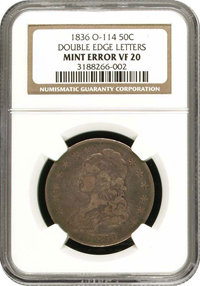
 NGC’s distinctive EdgeView™ holder gives collectors a unique view of lettered-edge coins, a feature of renewed interest in numismatics.
NGC’s distinctive EdgeView™ holder gives collectors a unique view of lettered-edge coins, a feature of renewed interest in numismatics.
Initiation of the Presidential Dollar coin program in 2007 brought about a renewed interest in lettered-edge coins, as most collectors were not in the habit of examining a coin’s “third side.” Applying text to the edges of its coins was a common practice at the US Mint from 1793 through 1836, when the feature was discontinued in favor of reeded or plain edges, exclusively. It was revived solely for the Saint-Gaudens Double Eagle of 1907–33, until being utilized once again for the current dollar coin program.
Different methods have been used to apply this lettering, but during the Mint’s early decades such edge lettering was performed prior to striking a coin’s obverse and reverse. A Castaing machine was utilized to squeeze incuse lettering and symbols into the planchet’s edge. This device consisted of two straight-edge dies, facing one another, parallel and at a distance of just slightly less than the planchet’s diameter. Each die carried one half of edge inscription in raised letters and symbols. One die was fixed in place, while the other moved when a crank was turned. The planchet was placed between the dies at one end of their parallel path, and the cranking action caused the planchet to rotate as it was squeezed between the moving and fixed-edge dies.
The geometric symbols that appeared on the edges of half dollars varied a bit between 1794 and 1836, but the lettering portion remained the same, reading FIFTY CENTS OR HALF A DOLLAR. The lettering operation was often imperfect, with portions of the inscription overlapping or missing in places. Since this lettering operation also produced a raised rim, incomplete lettering resulted in slight edge bulges and missing portions of the rim. More common was when the edge lettering operation overlapped due to the planchet slipping or being passed through the edge dies more than once. Al Overton’s reference book on early half dollars lists nearly six dozen comical variations of overlapping and duplicated lettering.
The coin illustrated here, submitted by Christopher Mang of Chris’ Coins, is boldly overlapped and doubled on its edge. An example of O-114, it is a relatively common die marriage that is spotted fairly easily by its clearly repunched seventh star. The doubled edge lettering is a feature that easily could have been overlooked. Instead, NGC’s distinctive EdgeView™ holder permits collectors to enjoy this numismatic bonus as never before.


